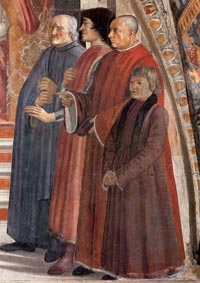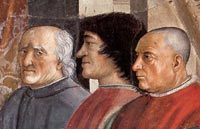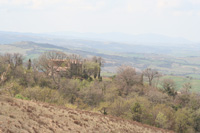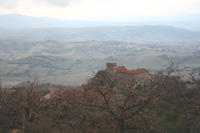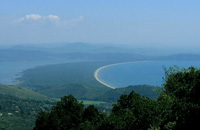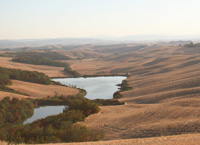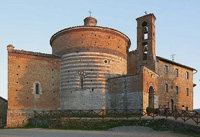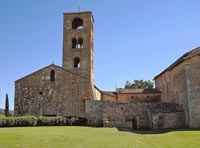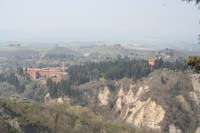 |
| Sandro Botticelli and Bartolomeo di Giovanni, La historia de Nastagio degli Onesti (third episode, detail), 1483, Madrid, Museo Nacional del Prado |
Sandro Botticelli | La historia de Nastagio degli Onesti |
In the 1480s Botticelli gained commissions from the families in high society. Increasingly they chose classical themes for the luxurious decoration of their town houses, but they also included some from contemporary literature. In order to be able to carry out his multiple commissions, Botticelli had to work together with other painters as well as members of his own workshop. The four panels conveying the Story of Nastagio degl Onesti, the eighth novel of the fifth day of Boccaccio's Decameron, were produced with the aid of Bartolomeo di Giovanni. |
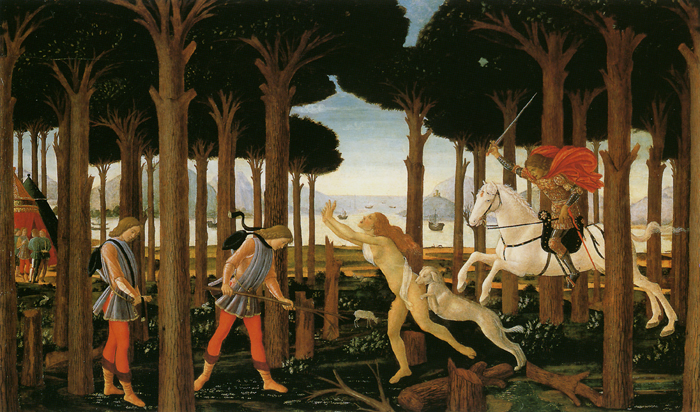 |
||
Sandro Botticelli and Bartolomeo di Giovanni, first episode of La historia de Nastagio degli Onesti, 1483, Madrid, Museo Nacional del Prado |
||
 |
||
Sandro Botticelli and Bartolomeo di Giovanni, second episode of La historia de Nastagio degli Onesti, 1483, Madrid, Museo Nacional del Prado |
||
|
||
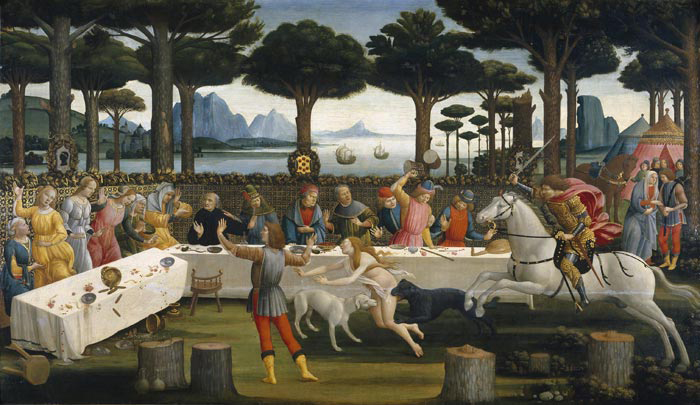 |
||
Sandro Botticelli and Bartolomeo di Giovanni, third episode of La historia de Nastagio degli Onesti, 1483, Madrid, Museo Nacional del Prado |
||
 |
||
Sandro Botticelli and Bartolomeo di Giovanni, fourth episode of Nastagio degli Onesti series, private collection in Palazzo Pucci, Florence (1483) |
||
| [1] The Pucci family was a major political family in Florence. The family surname derives from an ancestor named Jacopo, abbreviated to Jacopuccio, then to Puccio, who was considered wise and frequently called upon to settle disputes - there are records of two such interventions in 1264 and 1287. Their former surname seems to have been Saracini, which explains the presence of a maure or moor's head on their crest and coat of arms. The first Pucci family members to be mentioned date to the 13th century with their subscribing to the Arte dei Legnaioli. These early members include Antonio Pucci, who worked as an architect on the construction of the Loggia della Signoria. His son Puccio Pucci was a merchant who became rich thanks to trade and financial activities in medieval Florence. The first Pucci residences were in the Santa Croce district of Florence, before they moved to that of the church of San Michele Visdomini. They were Guelphs and so they were expelled and their houses demolished after the battle of Montaperti in 1260, though they were soon able to return upon the Ghibellines' explusion from the city. With wealth came political offices such as magistracies, priors and gonfalonieres - the Pucci family produced a total of 23 priors 8 holders of the post of confaloniere di giustizia. Constant allies of the Medici during the Renaissance, the Pucci were among the families Cosimo de'Medici called upon as a means of indirectly pursuing his own political interests - trusted Medici allies from the Pucci family included Puccio Pucci, who provided Cosimo with money to improve his living conditions in prison whilst Cosimo was imprisoned prior to being exiled. In the early 16th century the Pucci family's prestige rose yet higher, with it producing three cardinals (Roberto, Lorenzo and Antonio Pucci) within a few decades of each other and continuing to be trusted figures in the Medici's ducal and then grand-ducal courts. However, a momentary bitter break with the Medici came in 1559 when Pandolfo Pucci was ousted from the court of Cosimo I for various slanderous accusations of immorality or (according to other sources) for dreaming of restoring the ancient Republic of Florence. Thus, for revenge or ideological reasons, he conspired against Cosimo with the support of other noble Florentine families, intending to fire an arquebus at Cosimo as he and his retinue walked along the corner of Palazzo Pucci and Via de' Servi to get to the basilica della Santissima Annunziata. The plan had already been shelved, but the Medici intelligence network got wind of it, Pandolfo was hung from a window of the Bargello and the Pucci's properties were seized. As a memorial to the quashing of the plot, or perhaps out of prudence or superstition, it was decided to brick up the window at the corner where the attack was to have occurred, as can still be seen. The Pucci later made peace with the Medici and Niccolò Pucci regained the Palazzo Pucci and its furnishings. In 1662 Orazio Roberto Pucci acquired the fiefdom of Barsento (Bari) for 4,000 scudi and obtained the title of Marchese di Barsento, the noble title which has since been handed down through the family. The most recent notable family member has been Emilio Pucci, founder of the eponymous post-war fashion house, who became famous (above all in the 1960s and 70s) for more and more fancy but still refined designs. He designed the traditional uniform of the Italian Vigili Urbani with large white gloves and oval beret. His brother Puccio Pucci was also notable, as a sports official for CONI and other organisations. In the 1960s the two brothers split the Palazzo Pucci between them, with Emilio taking the left hand half as the main base for his fashion house and Puccio rebuilding the interior of the central part as a commercial gallery with small craft shops, as it still is today. The Santa Trinita church in Florence has several interesting works of art, but the piece de resistance is without doubt one of the finest and most complete remaining Renaissance chapels - Ghirlandaio's Capella Sassetti. The Sassetti Chapel was frescoed between 1482 and 1485 by Domenico Ghirlandaio. Puccio Pucci began the patronage of arts in the early Renaissance. |
|
|||
| In 1404 Antonio di Puccio Pucci acquired the chapel of San Sebastiano in the church of Santissima Annunziata, in which he placed the precious Piero del Pollaiolo painting of the Martyrdom of Saint Sebastian (now in the National Gallery, London). Puccio Pucci bought the Cappella della Madonna del Soccorso a few decades later. The family palazzo still contains one of the four paintings commissioned by Lorenzo the Magnificent from Sandro Botticelli as a gift to Giannozzo Pucci on Giannozzo's marriage to Lucrezia Bini in 1483. These paintings tell the story of Nastalgio degli Onesti and the first three in the narrative are now in the Prado in Madrid. The painting still in Florence shows the use of forks, which were traditionally adopted for the first time in Florence by the Pucci and whosa use Catherine de'Medici then spread right across Europe. It also shows the use of precious tableware and silver vessels, which really existed and were said to be from the workshops of Verrocchio and Pollaiolo. The Pucci commissioned several works for the churches neighbouring their palazzo. For the church of San Michele Visdomini, in 1518 Francesco Pucci commissioned Pontormo to paint the Holy family with saints, which was described by Vasari as one of the best paintings by an empolese painter. Whilst he was archbishop of Bologna, cardinal Antonio Pucci commissioned Raphael to paint a scene of The Ecstacy of Saint Cecilia - still in Bologna, it is now at the city's Pinacoteca. At the end of the 16th century Lorenzo Pucci commissioned Alessandro Allori to paint a Marriage at Cana as an altarpiece for the church of Sant'Agata (completed 1600). The family's palazzo was rebuilt by the grand-ducal architect Bernardo Buontalenti in the second half of the 16th century. Between 1585 and 1595 abbot Alessandro Pucci built the Villa di Bellosguardo, to designs by Giovanni Antonio Dosio - it remained a family property until 1858. The Pucci completed the portico of the church of Santissima Annunziata, in a stylistic unity with the piazza outside (the Pucci device is to be seen on the pavement in front of the entrance and on both sides of the portico) - an inscription on the frieze and a plaque on Via Gino Capponi gives its completion date as 1601. Palazzo Pucci is located in Via dei Pucci, 6, close toVia Cavour which leads to Piazza di San Marco. The design of the magnificent palace was commissioned by the Pucci family, in the second half of the 16th century, to the celebrated Tuscan mannerist architect and sculptor Bartolommeo Ammanatti (1511-1592). Art in Tuscany | Palazzi in Florence |
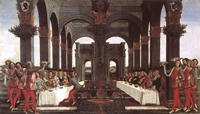 Sandro Botticelli, Nastagio degli Onesti, fourth panel |
|||
Domenico Ghirlandaio | The Sassetti Chapel in the Santa Trinita church in Florence |
||||
|
||||
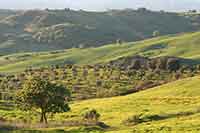 |
||||
Podere Santa Pia |
Castiglioncello Bandini |
Century-old olive trees, between Podere Santa Pia and Cinigiano |
||
Tombolo di Feniglia |
Crete Senesi, Asciano |
L'eremo di Montesiepi (the Hermitage of Montesiepi) |
||
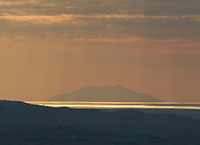 |
||||
Sovicille |
Monte Oliveto Maggiore abbey |
Sunsets in Tuscany |
||
 |
||||
| The valley below Santa Pia is a classic example of the Tuscan landscape, with endless hills, cypresses, wine, corn fields and streams, with strking view over the countryside, the Tyrrhenian coast and Monte Christo |
||||

